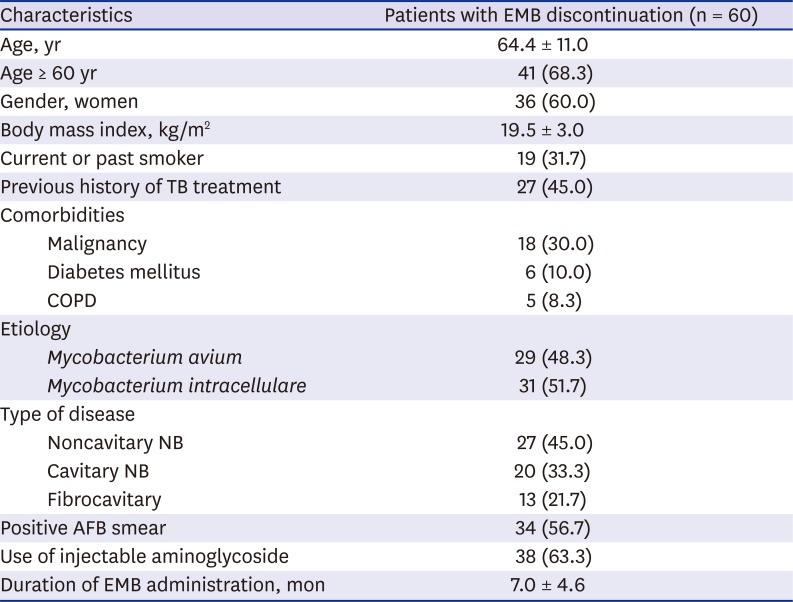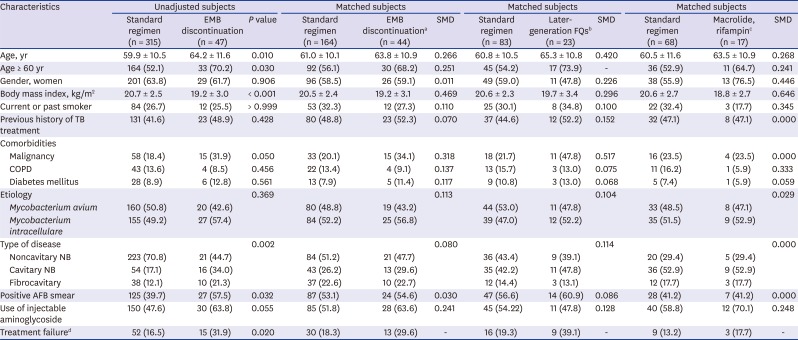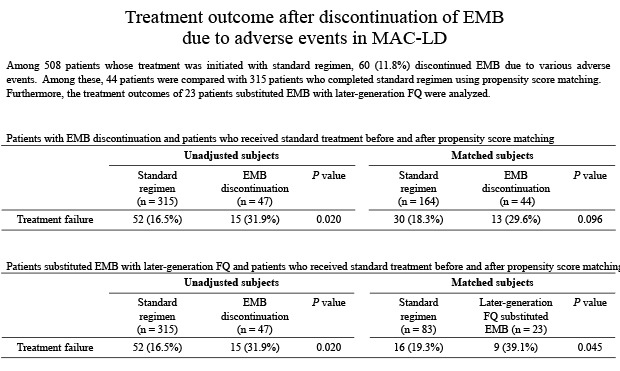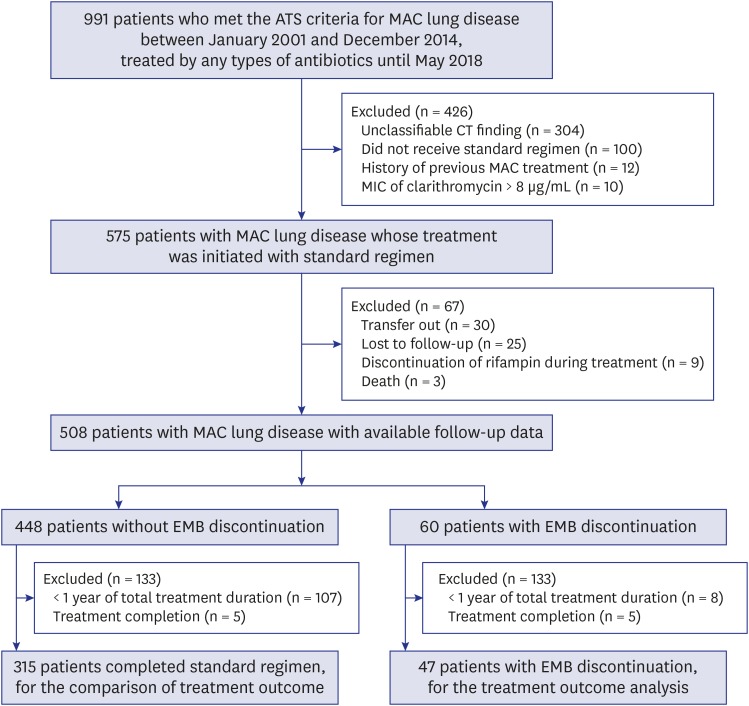1. Kwon YS, Koh WJ. Diagnosis and treatment of nontuberculous mycobacterial lung disease. J Korean Med Sci. 2016; 31(5):649–659. PMID:
27134484.

2. Ko RE, Moon SM, Ahn S, Jhun BW, Jeon K, Kwon OJ, et al. Changing epidemiology of nontuberculous mycobacterial lung diseases in a tertiary referral hospital in Korea between 2001 and 2015. J Korean Med Sci. 2018; 33(8):e65. PMID:
29441757.

3. Kwon YS, Koh WJ, Daley CL. Treatment of Mycobacterium avium complex pulmonary disease. Tuberc Respir Dis. 2019; 82(1):15–26.
4. Griffith DE, Aksamit T, Brown-Elliott BA, Catanzaro A, Daley C, Gordin F, et al. An official ATS/IDSA statement: diagnosis, treatment, and prevention of nontuberculous mycobacterial diseases. Am J Respir Crit Care Med. 2007; 175(4):367–416. PMID:
17277290.

5. Griffith DE, Brown-Elliott BA, Shepherd S, McLarty J, Griffith L, Wallace RJ Jr. Ethambutol ocular toxicity in treatment regimens for
Mycobacterium avium complex lung disease. Am J Respir Crit Care Med. 2005; 172(2):250–253. PMID:
15860751.
6. Kamii Y, Nagai H, Kawashima M, Matsuki M, Nagoshi S, Sato A, et al. Adverse reactions associated with long-term drug administration in
Mycobacterium avium complex lung disease. Int J Tuberc Lung Dis. 2018; 22(12):1505–1510. PMID:
30606324.
7. van Ingen J, Aksamit T, Andrejak C, Böttger EC, Cambau E, Daley CL, et al. Treatment outcome definitions in nontuberculous mycobacterial pulmonary disease: an NTM-NET consensus statement. Eur Respir J. 2018; 51(3):1800170. PMID:
29567726.

8. Koh WJ, Moon SM, Kim SY, Woo MA, Kim S, Jhun BW, et al. Outcomes of
Mycobacterium avium complex lung disease based on clinical phenotype. Eur Respir J. 2017; 50(3):1602503. PMID:
28954780.
9. Kwon BS, Kim MN, Sung H, Koh Y, Kim WS, Song JW, et al. In vitro MIC values of rifampin and ethambutol and treatment outcome in
Mycobacterium avium complex lung disease. Antimicrob Agents Chemother. 2018; 62(10):e00491-18. PMID:
30012759.

10. Kim OH, Kwon BS, Han M, Koh Y, Kim WS, Song JW, et al. Association between duration of aminoglycoside treatment and outcome of cavitary
Mycobacterium avium complex lung disease. Clin Infect Dis. 2019; 68(11):1870–1876. PMID:
30239615.
11. Loebinger MR.
Mycobacterium avium complex infection: phenotypes and outcomes. Eur Respir J. 2017; 50(3):1701380. PMID:
28954776.
12. Kwon BS, Shim TS, Jo KW. The second recurrence of MAC lung disease after successful treatment for first recurrence. Eur Respir J. 2019; 53(1):1801038. PMID:
30337449.
13. Adékambi T, Drancourt M, Raoult D. The rpoB gene as a tool for clinical microbiologists. Trends Microbiol. 2009; 17(1):37–45. PMID:
19081723.

14. Hwang JA, Kim S, Jo KW, Shim TS. Natural history of
Mycobacterium avium complex lung disease in untreated patients with stable course. Eur Respir J. 2017; 49(3):1600537. PMID:
28275170.
15. Wang MY, Sadun AA. Drug-related mitochondrial optic neuropathies. J Neuroophthalmol. 2013; 33(2):172–178. PMID:
23681241.

16. Jeong BH, Jeon K, Park HY, Kim SY, Lee KS, Huh HJ, et al. Intermittent antibiotic therapy for nodular bronchiectatic
Mycobacterium avium complex lung disease. Am J Respir Crit Care Med. 2015; 191(1):96–103. PMID:
25393520.
17. Carroll MW, Lee M, Cai Y, Hallahan CW, Shaw PA, Min JH, et al. Frequency of adverse reactions to first- and second-line anti-tuberculosis chemotherapy in a Korean cohort. Int J Tuberc Lung Dis. 2012; 16(7):961–966. PMID:
22584241.

18. Kwak N, Park J, Kim E, Lee CH, Han SK, Yim JJ. Treatment outcomes of
Mycobacterium avium complex lung disease: a systematic review and meta-analysis. Clin Infect Dis. 2017; 65(7):1077–1084. PMID:
28582488.
19. Conde MB, Efron A, Loredo C, De Souza GR, Graça NP, Cezar MC, et al. Moxifloxacin versus ethambutol in the initial treatment of tuberculosis: a double-blind, randomised, controlled phase II trial. Lancet. 2009; 373(9670):1183–1189. PMID:
19345831.

21. Fouad M, Gallagher JC. Moxifloxacin as an alternative or additive therapy for treatment of pulmonary tuberculosis. Ann Pharmacother. 2011; 45(11):1439–1444. PMID:
21990937.

22. Griffith DE. Macrolide-resistant
Mycobacterium avium complex: “I feel like I'e been here before”. Ann Am Thorac Soc. 2016; 13(11):1881–1882. PMID:
27831800.
23. Jenkins PA, Campbell IA, Banks J, Gelder CM, Prescott RJ, Smith AP. Clarithromycin vs ciprofloxacin as adjuncts to rifampicin and ethambutol in treating opportunist mycobacterial lung diseases and an assessment of Mycobacterium vaccae immunotherapy. Thorax. 2008; 63(7):627–634. PMID:
18250184.

24. Jacobson MA, Yajko D, Northfelt D, Charlebois E, Gary D, Brosgart C, et al. Randomized, placebo-controlled trial of rifampin, ethambutol, and ciprofloxacin for AIDS patients with disseminated
Mycobacterium avium complex infection. J Infect Dis. 1993; 168(1):112–119. PMID:
8515098.
25. Bermudez LE, Inderlied CB, Kolonoski P, Petrofsky M, Aralar P, Wu M, et al. Activity of moxifloxacin by itself and in combination with ethambutol, rifabutin, and azithromycin in vitro and in vivo against
Mycobacterium avium
. Antimicrob Agents Chemother. 2001; 45(1):217–222. PMID:
11120969.
26. Bermudez LE, Kolonoski P, Petrofsky M, Wu M, Inderlied CB, Young LS. Mefloquine, moxifloxacin, and ethambutol are a triple-drug alternative to macrolide-containing regimens for treatment of
Mycobacterium avium disease. J Infect Dis. 2003; 187(12):1977–1980. PMID:
12792877.
27. Sano C, Tatano Y, Shimizu T, Yamabe S, Sato K, Tomioka H. Comparative in vitro and in vivo antimicrobial activities of sitafloxacin, gatifloxacin and moxifloxacin against
Mycobacterium avium. Int J Antimicrob Agents. 2011; 37(4):296–301. PMID:
21353489.
28. Morimoto K, Namkoong H, Hasegawa N, Nakagawa T, Morino E, Shiraishi Y, et al. Macrolide-resistant
Mycobacterium avium complex lung disease: analysis of 102 consecutive cases. Ann Am Thorac Soc. 2016; 13(11):1904–1911. PMID:
27513168.
29. Moon SM, Park HY, Kim SY, Jhun BW, Lee H, Jeon K, et al. Clinical characteristics, treatment outcomes, and resistance mutations associated with macrolide-resistant
Mycobacterium avium complex lung disease. Antimicrob Agents Chemother. 2016; 60(11):6758–6765. PMID:
27572413.







 PDF
PDF Citation
Citation Print
Print





 XML Download
XML Download